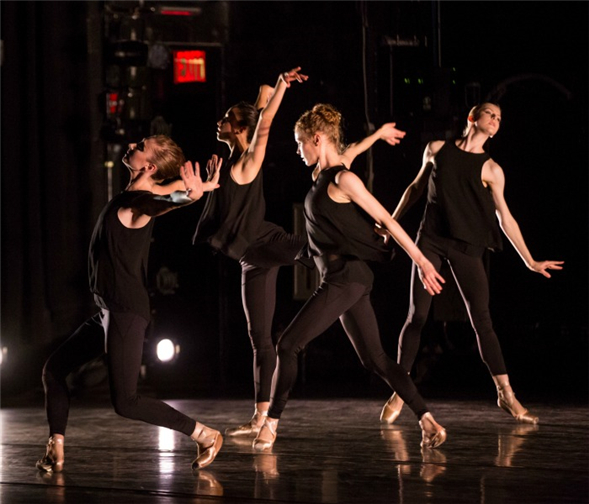Translate Page

For BalletCollective's new works, choreographer Troy Schumacher called on some unlikely collaborators
---
When an emerging dance company opts for a nontraditional approach, it can quickly go awry. Too much gimmick, not enough goods. Fortunately, Troy Schumacher has avoided that common misstep with his troupe BalletCollective by devising a singular yet solid collaborative setup: Each season, he chooses a new art form for inspiration, and his choreography flows from that source.
Architecture is BalletCollective's muse for What Comes Next, a pair of pieces premiering October 27 and 28 at NYU Skirball. Performed alongside 2015's Invisible Divide, the new works were created with composers Ellis Ludwig-Leone and Judd Greenstein, as well as architects James Ramsey and Carlos Arnaiz. Schumacher was intrigued by dance, music, and architecture's similar focus on structure, and wanted to investigate the contrast of ephemeral movement and (comparatively) permanent buildings. He had a hunch that responding to an agent outside of the fine arts would push him to unearth innovative steps. Plus, a stonier starting point presented an unfamiliar yet appealing counterpoint to his previous oeuvre.
"When we've worked with poets and photographers, those interactions have led us to create emotion-driven work," says Schumacher. "But I am now thinking about the repertoire we're building and what might offer a worthwhile contrast. And, choreographically, sometimes going against your instincts helps you develop."
While BalletCollective's previous artistic collaborations provoked loosely narrative, emotionally charged pieces, Schumacher thought architecture might be able to inspire more abstract work. This pendulum swing provided an appealing choreographic challenge. "It felt like the natural next step for the development of my work," Schumacher says. Also, since New York City is currently exploding with novel approaches to building -- like Ramsey's in-progress underground park the Lowline -- Schumacher saw a reflection of his own evolving creativity.
{Image1}
A slew of potential collaborators were identified. However, since this wasn't a straightforward commission, not everyone was willing to work in such an unorthodox manner. So when Ramsey and Arnaiz expressed an interest, Schumacher leapt at the opportunity.
As is his standard, Schumacher started each collaboration with a conversation. While he usually knows the general parameters for a project (a 25-minute piece with eight dancers, for example), he initiates the interaction with minimal expectations. "We talk about what's interesting to us right now and find common ground," he says. "In James Ramsey's case, we talked about his Lowline. That sparked his concepts, and a coherent vision started popping up. But, as with every season, these are not ballets made of the sources, per se, but ballets that can't exist without them. We digest what the artist sends, and then figure out what it looks and sounds like." In this case, that means movements evoking elements like cement, plant life, and the Lowline's skylights in choreographic sections Schumacher calls "Walls."
Unexpectedly, for his work with Carlos Arnaiz, the element of sports emerged as essential. "We were discussing basketball legend Allen Iverson, who scored baskets in creative ways, and Carlos sent us this sketch of him," Schumacher explains. "On top of it, he drew what was actually happening in it: the arc of ball, the lines of Iverson's body, the lines of vision from the other players. The image had such energy to it, and immediately Judd, the composer, and I were connected to it. We knew we were going to do an energetic, short work."
While Schumacher tries to avoid preconceived notions in the studio, he does read the score endlessly to memorize each beat. Before rehearsals begin, he also moves a bit in the studio to find starting points. Then, he takes the ideas to his dancers.
"It can be challenging to meet with dancers with a completely blank mind," he explains. "It's like looking at a huge, blank canvas. Where will you start the brush? So I find things to help me build momentum. But since the way each dancer moves is so different, I highly value what they can offer to the process."
Through this particular journey, Schumacher found a deeper connection to architecture than he imagined possible, proving his initial instinct was spot-on, with BalletCollective's collaborative system effective in both process and performance. "Like a building you walk through, choreography and music must have structure and flow," he says. "The whole of it has to be viable and solid, but the details must also be there. In that way, the source art is a tool and springboard for communication, a shared language. When I can absorb multiple things, my consciousness can create a cohesive, more interesting vision."
---
Lauren Kay frequently writes about dance for TDF Stages.
Photos by Matthew Murphy
TDF MEMBERS: Browse our discounted tickets to theatre, dance, and concerts.